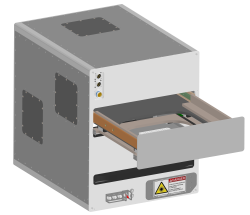1.21 Three-Dimensional Imaging and Analysis
- Includes z-axis stacking to produce enhanced depth of focus imaging.
- Provides 6 modes of 3D viewing including stereo 3D and motion 3D video.
- HNu-Edge 3D computer and Panfocal software will facilitate the processing and analysis of the 3D images captured onboard the ISS-NL.
1.22 High Numerical Aperture Lenses
- Ranging in magnification from 40X to 100X for enhanced-resolution imaging at high magnifications.
1.23 Fluorescence Microscopy
PIMMS will support fluorescence microscopy investigations.
- Epi-fluorescence illumination.
- Multiple illumination sources to provide a wide range of excitation options from 400-700 nm will be available with automated selection and control to provide illumination for a diverse array of fluorescent samples.
- Automated turrets will provide the selection of different dichroic filter options and filter sets to ensure high throughput of the emission signal to the camera for efficient fluorophore detection with emissions from 425- 750 nm wavelength band.
1.24 Confocal Scanner Microscopy
PIMMS also provides a confocal imaging mode as an added feature for microgravity researchers.
- Automated selection between standard imaging mode and confocal imaging mode.
- Capable of confocal fluorescence imaging.
- Automated control of confocal fluorescent illumination sources.
- Selected confocal specific dichroic, excitation, and emission filters will provide high levels of throughput to the camera.
1.25 Polarization Microscopy
PIMMS will be outfitted with a polarization system to allow researchers to investigate birefringent properties of fluids and materials onboard the ISS-NL.
-
The system will include rotatable polarizers and analyzers that will reveal the birefringence in specimens, allowing researchers to study ceramics, fibers,
polymers, and a range of biological macromolecules.
- PIMMS is designed so that the processes of polymerization and crystal formation can be seen polarized, in 3D and with time-lapse capabilities.
1.26 Ground-Based Experiment Replicate
A replicate PIMMS facility will be available to investigators to conduct their ground control experiments to support their microgravity investigations on the ISS-NL.
The ground-based PIMMS facility will have the same microscopy capabilities as the on-orbit PIMMS facility. The ground based experiment replicate package will provide
investigators with the option to perform a ground control experiment in conjunction with their on-orbit experiment. If an investigator chooses to use additional
offerings (high N.A. lenses, fluorescence, polarized, 3D or confocal microscopy) the ground-based replicate experiment will perform the same operations at no additional
cost.
